![]()
![]()
![]()
Use LEFT and RIGHT arrow keys to navigate between flashcards;
Use UP and DOWN arrow keys to flip the card;
H to show hint;
A reads text to speech;
54 Cards in this Set
- Front
- Back
|
What is the spinal cord segment for the Musculocutaneous nerve? |
C5, C6 (also C7, but not listed in little book) |
|
|
what muscles does the musculocutaneous nerve innervate? |
coracobrachialis biceps brachii brachialis |
|
|
What is the sensory distribution of the musculocutaneous nerve? |
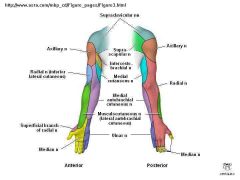
anterolateral surface of the forearm (green in the pic on the forearm) |
|
|
what are the features of musculocutaneous peripheral nerve paralysis? |
loss of elbow flexion when supinated weakened supination |
|
|
What are the spinal cord segments for the Axillary nerve? |
C5, C6 |
|
|
What muscles does the axillary nerve innervate? |
deltoid and teres minor |
|
|
What is the sensory distribution supplied by the axillary nerve? |
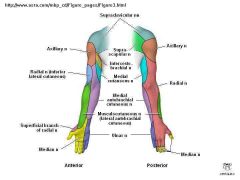
lateral arm over lower portion of deltoid (orange in the pic) |
|
|
what are the motor features of axillary nerve paralysis |
loss of shoulder abduction weakened shoulder ER |
|
|
What are the spinal cord segments for the Radial nerve? |
C5, C6, C7, C8, T1 (T1 has inconsistent contribution. *Note little book does not say C5) |
|
|
What muscles does the radial nerve innervate? |
triceps, anconeus, brachioradialis, supinator, wrist, finger and thumb extensors * E TABS |
|
|
what is the sensory distribution of the Radial nerve? |
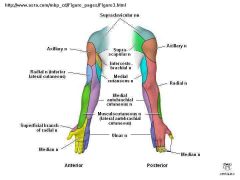
posterior arm, forearm and radial side of hand and digits 1-3 up to DIP and radially half of 4th up to DIP (pink in the pic) |
|
|
what are the motor features of radial nerve paraysis? |
loss of elbow, wrist, finger, and thumb extension (every mm with extensor word in it & Abductor Pollicis longus) |
|
|
What are the spinal cord segments of the Median nerve? |
C5, C6, C7, C8, T1 (T1 has inconsistent contribution. *Note little book does not say C5) |
|
|
what muscles are innervated by the median nerve? |
pronators, wrist and finger flexors on radial side, most of thumb muscles -FCR -PT -PL -FDS -FPL -FDP (of digits 2 and 3) -PQ -APB -OP -FPB -Lumbricals 1 & 2 All Anterior Forearm and 1/2 LOAF |
|
|
what is the sensory distribution of the median nerve? |
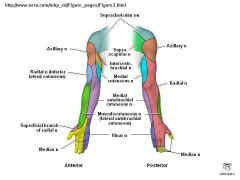
palmar aspects of the thumb-3rd digit and radial half of palmar aspect of the 4th digit and Distal tips of digits 1-3 and radial half of distal tip of 4th digit (yellow in the pic) |
|
|
what are the motor features of median nerve paralysis? |
loss of forearm pronation thumb opposition thumb flexion and abduction (lateral pinch instead of pad-to-pad) Carpal tunnel syndrome thenar eminence atrophy |
|
|
what spinal cord segments does the ulnar nerve arise from? |
C8-T1 |
|
|
What muscles are innervated by the ulnar nerve? |
FCU FDP (4&5) Dorsal and Palmar Interossei lumbricals of 4 and 5 Adductor Pollicis AbDM ODM FDM
|
|
|
what is the sensory distribution of the ulnar nerve? |
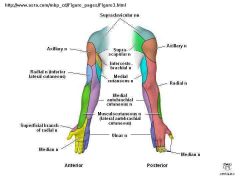
medial half of the palmar and dorsal surfaces of the 4th digit 5th digit medial palmar and dorsal surfaces of hand (purple in the pic) |
|
|
What are motor features of ulnar nerve paralysis? |
loss of wrist ulnar deviation weakened wrist and finger flexion weakened 4th and 5th DIP flexion loss of thumb adduction loss of most intrinsic hand muscles (claw hand) |
|
|
What are the spinal cord segments of the sciatic nerve? |
L4-S3 |
|
|
what muscles does the sciatic nerve innervate? |
Hamstrings Adductor Magnus |
|
|
what is the sensory distribution of the sciatic nerve? |
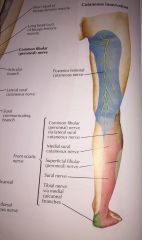
posterior/lateral calf, ankle and heel (pink in pic) |
|
|
what are the motor features of sciatic nerve paralysis? |
loss of knee flexion weak hip adduction loss of all muscle function below the knee |
|
|
What are the spinal cord segments of the femoral nerve? |
L2, 3, 4 |
|
|
What are the muscles innervated by the femoral nerve? |
Q SIP Quadriceps Sartorius Iliacus Pectineus |
|
|
what is the sensory distribution of the femoral nerve? |
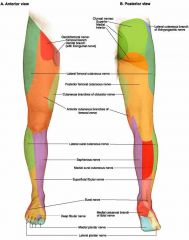
middle anterior thigh and anterior medial leg and medial calf distal to knee (see pg. 538 of Netters) (dark orange in pic) |
|
|
what are the motor features of paralysis for the femoral nerve? |
loss of hip flexion and knee ext |
|
|
what are the cord segments of the tibial nerve? |
L4-S3
|
|
|
what are the muscles innervated by the tibial nerve? |
gastrocnemius soleus (superificial posterior compartment) plantaris popliteus tibialis posterior FDL FHL (i.e. deep posterior compartment) |
|
|
what is the sensory distribution of the tibial nerve? |
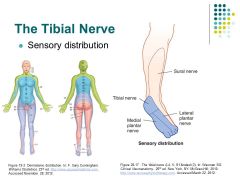
posterior/lateral calf, ankle and heel tibial nn. specifically: plantar surface of foot (except margins of posterior medial and lateral side) & posterior distal heel pg. 540 of netter's |
|
|
What are the motor features of tibial nerve paralysis? |
loss of PF and supination |
|
|
What are the cord segments of the superficial peroneal (fibular) nerve? |
L5-S2 |
|
|
what muscles are innervated by the superficial peroneal nerve? |
peroneus longus and brevis |
|
|
what is the sensory distribution of the superficial peroneal nerve? |
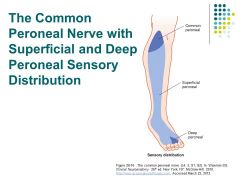
anterior/medial distal lower leg and ankle most of dorsum of foot except web space between 1st and 2nd digit and lateral border of the 5th metatarsal (sural nn) |
|
|
what are motor features of superificial peroneal nerve paralysis? |
loss of eversion |
|
|
What are the the cord segments of the deep peroneal nerve? |
L4-S2 |
|
|
what muscles are innervated by the deep peroneal nerve? |
PETE DEE tibialis anterior EHL EDL peroneus tertius 1st and 2nd dorsal interossei EDB EHB |
|
|
What is the sensory distribution of the deep peroneal nerve? |
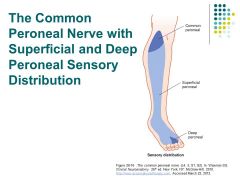
web space between first and 2nd toes on dorsum of foot |
|
|
what are motor features of paralysis of the deep peroneal nerve? |
loss of DF (drop foot) weakness in the foot intrinsics |
|
|
Name the cranial nerves. |
Olfactory CN I Optic CN II Oculomotor CN III Trochlear CN IV Trigeminal CN V Abducens CN VI Facial VII Vestibulocochlear VIII (Acoustic) Glossopharyngeal IX Vagus X Spinal Accessory XI Hypoglossal XII |
|
|
What is the function of CN I? and what does damage cause? |
function: smell damage: ANOSMIA (loss of sense of smell) *Smell your finger (1 finger = CN 1 for smell)
|
|
|
What is the function of Optic nerve (CN II)? and what does damage cause? |
function: sight/vision, PUPILLARY REFLEXES damage: MONOCULAR blindness, LOSS of pupillary CONSTRICTION, absence of BLINK REFLEX *With 2 fingers point to your eyes **This crosses at the optic chiasm so L 1/2 field comes from R and vice versa |
|
|
What is the function of Oculomotor CN III? and what does damage cause? |
function: moves the eye and elevates the UPPER EYELID damage: PTOSIS (drooping eyelid) DILATION of pupil/loss of accomodation of the LIGHT reflex *Point with 1 finger and look with 2 eyes = CN 3 |
|
|
What is the function of the Trochlear CN IV? and what does damage cause? |
function: innervates the SUPERIOR OBLIQUE MM (moves eye out and down) damage: diplopia, FAILURE TO ROTATE EYE UP AND OUT (head tilt up and inclined to the opposite side) *place 2 fingers on each side of our eyes and move them out and down |
|
|
What is the function of Trigeminal CN V? and what does damage cause? |
Function: motor innervation of mm of MASTICATION and sensory nerve for the head damage: loss of FACIAL SENSATION, weakness of mm of mastication, deviation of opened jaw to IPSILATERAL side *Wipe forehead (ophthalmic), from eye to top of mouth (maxillary), and across chin (mandibular) [sensory] and bite (mms of mastication) [motor]
|
|
|
What is the function of Abducens CN VI? and what does damage cause? |
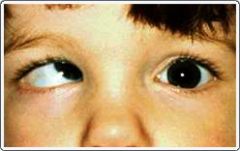
Function: abducts the eye via nerve supply to LATERAL RECTUS MM Damage: diplopia, convergent squint (MEDIAL STRABISMUS), abductor paralysis of IPSILATERAL eye |
|
|
What is the function of Facial nerve (CN VII)? and what does damage cause? |
Function: facial expression, speech ARTICULATION , winking,INGESTION of food and drink, taste, salivary and nasal SECRETIONS Damage: IPSAILATERAL facial PARALYSIS loss of TASTE on anterior 2/3 of tongue (BELL'S Palsy) *Think of a spider on your face that you try to make a bunch of faces to get off and you can't, so you start crying a drooling and when you try to suck the drool back in you suck in the spider that you can taste with the anterior 2/3 of your tongue! |
|
|
What is the function of Vestibulocochlear CN VIII? and what does damage cause? |
Function: maintenance of equilibrium and hearing Damage: vertigo, nystagmus, dysequilibrium, tinnitus, loss of hearing *Place 4 fingers of each hand behind each of your two ears. |
|
|
What is the function of Glossopharyngeal CN IX? and what does damage cause? |
Function: taste, ELEVATES PHARYNX, SALIVARY SECRETIONS (testing: say 'ahh' and watch for symmetrical elevation) Damage: slight DYSPHAGIA, partial dry mouth, loss of taste on posterior 1/3 of tongue *Place nine fingers on your throat and make a funny noise using the back 1/3 of your tongue; CN 9; elevates pharynx and taste with past 1/3) |
|
|
What is the function of Vagus CN X? and what does damage cause? |
Function: phonation, visceral sensations and reflexes, cardiac depressor, bronconstrictor, GI tract peristalis and secretion Damage: palpitation, tachycardia, vomiting slowing of respiration UMN: uvula deviates toward lesion; ipsilat paralysis of soft palate and larynx LMN: uvula deviates contralat to lesion hoarseness anesthesia of larynx *hands across neck and chest as this affects a lot in these areas |
|
|
What is the function of Accessory CN XI? and what does damage cause? |
Function: swallowing (deglutition) and phonation movements of head and neck (SCM and Trapes) Damage: weakness in shrugging ipsilat shoulder and turning head to contralat side *place 1 finger on each side on the SCM and upper traps |
|
|
What is the function of Hypoglossal CN XII? and what does damage cause? |
Function: movements of tongue Damage: unilat paralysis of tongue LMN (nuclear or peripheral lesion) deviation to the ipsilat side during protrusion UMN: tongue deviates contralat to side of lesion *Hold out your 10 fingers and with 1 from each hand point to the tongue
|
|
|
To remember the cranial nuns by name in order and to identify if they are sensory, motor, or both. |
-On Old Olympus Towering Tops A Fin And German Viewed Some Hops -Some Say Marry Money, But My Brother Says Big Brains Matter Most 1- (On / Some) Olfactory- Sensory 2- (Old / Say) Optic - Sensory 3- (Olympus / Marry) Oculomotor - Motor 4- (Towering / Money) Trochlear - Motor 5- (Tops / But) Trigeminal - Both 6- (A / My) Abducens - Motor 7- (Fin / Brother) Facial - Both 8- (And / Says) Acoustic/Vestibulochoclear - Sensory 9- (German / Big) Glossopharangeal - Both 10-(Viewed / Brains) Vagus - Both 11- (Some / Matter) Spinal Accessory - Motor 12 (Hops / Most) Hypoglossal - Motor |

